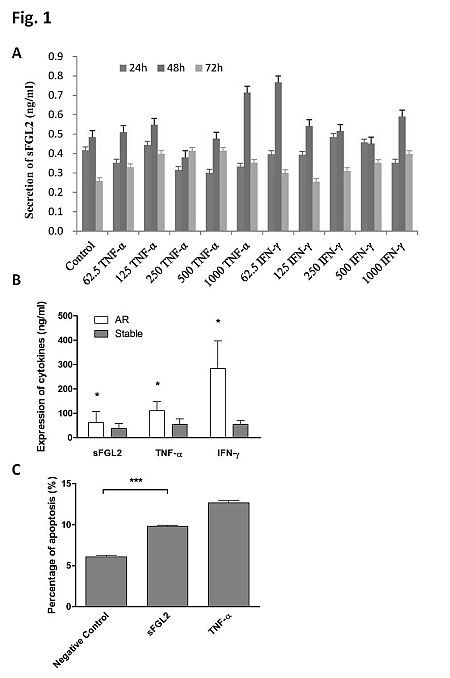Soluble FGL2 Mediates Acute Rejection in Renal Allograft Recipients by Inducing Tubular Epithelial Cells Apoptosis
Zhongshan Hospital, Fudan University, Shanghai, China
Shanghai Key Laboratory of Organ Transplantation, Shanghai, China
Meeting: 2013 American Transplant Congress
Abstract number: B877
Background: Acute rejection (AR), initiated by infiltrating alloreactive T cells, hampers renal allograft survival. Tubular epithelial cells (TECs) are primary target in AR. TECs apoptosis contributes to premature graft loss, while the mechanism has not been clarified. Soluble fibrinogen-like protein 2 (sFGL2), mainly secreted by T cells, can induce apoptosis. In this study, the role of T cell-secreted sFGL2 in AR patients and its impact on TECs was investigated.
Materials and Methods: The serum level of sFGL2, TNF-Α and IFN-Γ was detected by ELISA and the percentage of CD4+ T cells in the peripheral blood by flow cytometry in renal allograft recipients with AR (n=20), compared to those with stable renal function (n=30). The isolated human CD4+ T cells were stimulated with TNF-Α (67.5, 125, 250, 500, 1000U/ml), IFN-Γ (67.5, 125, 250, 500, 1000U/ml) or saline for 24-h, 48-h and 72-h, and sFGL2 production was examined by ELISA. Furthermore, TECs were stimulated with 10Μg/ml sFGL2, 10ng/ml TNF-Α as positive control or saline as negative control for 48-h, and apoptosis was investigated by flow cytometry. Approval for this study was obtained from the ethics committee of Fudan University.
Results: In the peripheral blood of renal allograft recipients with AR, the level of sFGL2, TNF-Α, IFN-Γ, and the percentage of CD4+ T cells were significantly higher than those with stable renal function. CD4+ T cells produced more sFGL2 in 48-h culture than 24-h and 72-h. With the stimulation of 1000U/ml TNF-Α or 62.5U/ml IFN-Γ, CD4+ T cells secreted the highest level of sFGL2. Moreover, sFGL2 remarkably induced TECs apoptosis, while there was no significant difference between sFGL2 and TNF-Α.
Conclusion: Serum sFGL2 was significantly increased in renal allograft recipients with AR. sFGL2 was promoted by TNF-Α and IFN-Γ in CD4+ T cells and induced the TECs apoptosis in vitro. This study suggested that sFGL2 might be a mediator of T cell-induced TEC injury in renal allograft acute rejection, and a potential target for clinical AR therapy.

To cite this abstract in AMA style:
Zhao Z, Yang C, Wang L, Li L, Zhao T, Wu D, Rong R, Xu M, Zhu T. Soluble FGL2 Mediates Acute Rejection in Renal Allograft Recipients by Inducing Tubular Epithelial Cells Apoptosis [abstract]. Am J Transplant. 2013; 13 (suppl 5). https://atcmeetingabstracts.com/abstract/soluble-fgl2-mediates-acute-rejection-in-renal-allograft-recipients-by-inducing-tubular-epithelial-cells-apoptosis/. Accessed December 21, 2025.« Back to 2013 American Transplant Congress
